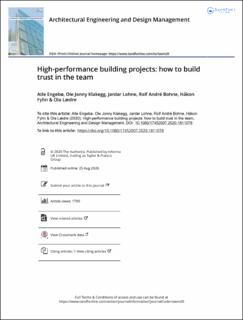| dc.description.abstract | Trust is a prerequisite in all endeavours concerning uncertainty and interdependencies. By studying the development of a sustainable, high performing building this paper report on such an endeavour. The client implemented a collaborative project delivery method where key actors were brought together to collaboratively develop the project in the design phase. For the participants to collaborate, and thus work as a high-performance team, there was a need for trust. Therefore, this study addresses the following research questions: what was perceived as the key elements for building trust in this project? and, how did the key elements impact the trust-building in this project? The study is based on observations of weekly design meetings (so-called Big-Room sessions), as well as secondary data from a document study, and a supplementary questionnaire. Trust was essential as the participants were able to rely on each other’s expertise and work interdependently towards a common goal. The most prominent elements that affected trust were the start-up seminar, team composition, shared interest, support from management, joint problem solving, and the use of integrated concurrent engineering. These elements built and sustained trust due to their ability to create or positively impact the experiences, problem-solving, shared goals, reciprocity, and reasonable behaviour of the project team. The insight into how the collaborative project delivery method build trust may be valuable for practitioners and researchers alike. | en_US |

